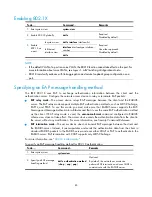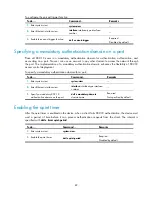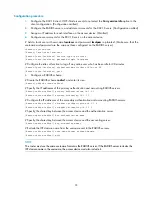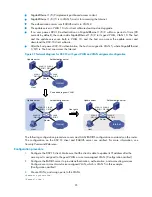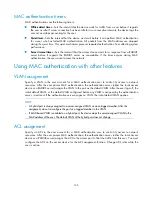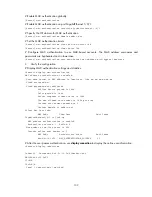
95
•
GigabitEthernet 1/0/2 implements port-based access control.
•
GigabitEthernet 1/0//3 is in VLAN 5 and is for accessing the Internet.
•
The authentication server runs RADIUS and is in VLAN 2.
•
The update server in VLAN 10 is for client software download and upgrade.
•
If no user passes 802.1X authentication on GigabitEthernet 1/0/2 within a period of time (90
seconds by default), the router adds GigabitEthernet 1/0/2 to its guest VLAN, VLAN 10. The host
and the update server are both in VLAN 10, and the host can access the update server and
download the 802.1X client software.
•
After the host passes 802.1X authentication, the host is assigned to VLAN 5, where GigabitEthernet
1/0/3 is. The host can access the Internet.
Figure 37
Network diagram for 802.1X with guest VLAN and VLAN assignment configuration
Internet
Update server
Authentication server
Host
VLAN 10
GE1/0/1
VLAN 10
GE1/0/2
VLAN 5
GE1/0/3
VLAN 2
GE1/0/4
Router
Internet
Update server
Authentication server
Host
VLAN 10
GE1/0/1
VLAN 1
GE1/0/2
VLAN 5
GE1/0/3
VLAN 2
GE1/0/4
Router
Internet
Update server
Authentication server
Host
VLAN 10
GE1/0/1
VLAN 5
GE1/0/2
VLAN 5
GE1/0/3
VLAN 2
GE1/0/4
Router
Port added to guest VLAN
User gets
online
The following configuration procedure covers most AAA/RADIUS configuration commands on the router.
The configuration on the 802.1X client and RADIUS server are omitted. For more information, see
Security Command Reference
.
Configuration procedure
1.
Configure the 802.1X client. Make sure that the client is able to update its IP address after the
access port is assigned to the guest VLAN or a server-assigned VLAN. (Configuration omitted)
2.
Configure the RADIUS server to provide authentication, authorization, and accounting services.
Configure user accounts and server-assigned VLAN, which is VLAN 5 in this example.
(Configuration omitted)
3.
Create VLANs, and assign ports to the VLANs.
<Router> system-view
[Router] vlan 1



